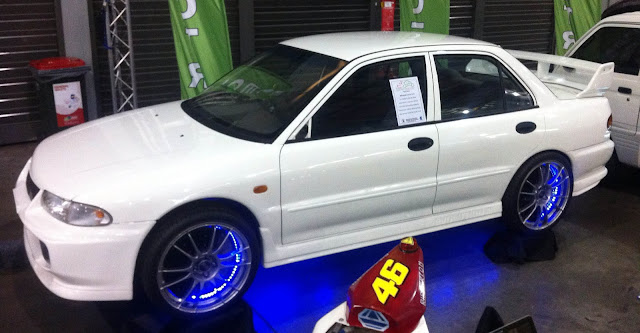Mitsubishi Australia were generous enough to recently loan EV News an iMiEV for a week.
On sale in Australia since 2010, the Mitsubishi iMiEV is based on a Japanese Kei class Mitsubishi I that was first released in 2006.
The iMiEV has the same sized lithium ion battery (16 kWh) as the Holden Volt but because it is a much smaller car and doesn't cart around a full sized 1.4 Lt petrol engine range extender the iMiEV weighs only 1,080 kg Vs 1,715 kg for the Volt. Where the Volt routinely achieves 70 - 80 km from a full charge in EV mode the book spec for the iMiEV is 155 km which is approximately twice the distance for the same battery capacity.
For a 5 door hatchback with only 47 kw (63 hp) and 180 Nm (133 lb/ft) from it's BLDC permanent magnet electric motor mated to a 7.065:1 single speed reduction gearbox, acceleration, while not startling off the line, is very impressive above 50 km/h right up to the cars top speed of 130 km/h. The combination of small road foot print and brilliant mid-speed acceleration brings a whole new dimension to 'gap-shooting' in heavy urban traffic.
The iMiEV's dash board instruments aren't as flash as a Volt with a basic set of segmented LCD meters instead of the all-singing all-dancing colour graphics of the Volt, but the relevant information like State Of Charge (SoC), energy consumption and predicted range are all present.
During our week long test drive we didn't quite get a handle on the algorithm behind the iMiEVs range meter. Driving the iMiEV on surface roads at speeds below 60 km/h with the 'gear' selector in the 'B' maximum brake regeneration position, it was possible to not only travel many kilometers without the indicated range changing at all, but we even managed to leave one morning with a full change indicating 106 km range and travelled to our destination 24 km away having used 2 bars on the battery meter (12.5%) with predicted range having gone UP to 113km by the time we arrived?
While low speed urban driving is definitely the iMiEV's forte, high speed motorways are not. We all know that aerodynamic drag increases in proportion to the square of speed ie doubled speed results in four times as much drag. Unfortunately, despite the blunt nose and steeply raked windscreen the iMiEV's coefficient of drag is no better than a large family sedan @ 0.33 Cd. We even double checked by multiplying the frontal cross sectional area to get the CdA figure but the result was still about equal.
Aside from the fact it doesn't have a cruise control which is unusual for a modern car, the range meter plummets when driven for sustained periods above 100 km/h. This serves as a graphic illustration of the extra loads ALL cars face at higher speeds. It only becomes much more noticeable in the iMiEV because a/ The battery capacity is equivalent to having a 1.5 litre fuel tank (petrol contains 10 kWh per litre) b/ ICE cars are so inefficient at low speeds compared to the iMiEV the difference between high and low speed fuel consumption of an ICE car isn't as noticeable as with the iMiEV.
Like Charging an iPhone
Here in Australia 240 VAC is the standard voltage that all appliances run off so the iMiEV can be fully changed in 8 hours using a standard 10 amp supply (although the iMiEV lead has a 15A plug). In the week we had the car we never used much more than ½ the battery on any given day of running errands so plugging it in for a 4 hour re-charge didn't seem much different to plugging in the iPhone / iPad on a daily basis.
The iMiEV has 2 charge sockets, one on either side of the car, with 240v on the drivers (right) side and a large CHAdeMO charger socket under the left hand side filler flap.
In order to test how practical fast charging is we took a drive to the the NRMA DC Fast Charger installed across the road from their North Strathfield head office. Arriving with 55% charge remaining the battery quickly accepted the 359 volts / 125 amps on offer and was topped up to 80% in 11 minutes flat. While the NRMA fast charger is located near a popular restaurant/cafe precinct, and is free of charge to use, 10 minutes isn't even enough time for a coffee although a full 20 min charge might allow enough time for a stroll to get a cappuccino.
With an introduction price of A$65,000, which was reduced to A$48,880 in 2011, the Mitsubishi iMiEV hasn't exactly been selling like hot cakes with only 227 cars delivered locally. Yet 33,000 have been sold worldwide including Peugeot and Citroen versions with Japan, France and Norway being the top selling countries.
Mitsubishi Australia are now selling the last of their 70 remaining iMiEVs and have no plans to order more unless there is customer demand. Dealers have reduced the new price to A$24,990 with rumours doing the rounds that an ex-demo with 10k on the clock can be had for as little as A$20k.
Sure it is a first generation EV in a market where the technology is evolving rapidly, but with local fuel prices currently above 2008 levels and oil prices having just passed A$120, anything electrically powered is looking better by the day.
I certainly wasn't keen to return the iMiEV, which cost approx $2.00 a day to charge, to resume pumping the usual $80 worth of fuel per week. Anyone with a roof-top PV solar system should be giving an iMiEV serious consideration as they can dramatically shorten the payback period of the PV system by eliminating fuel costs instead of utility bills and effectively power the iMiEV free of charge for the next 10-20 years. The EV grin as you drive past $1.70/Lt fuel billboards is almost priceless.







